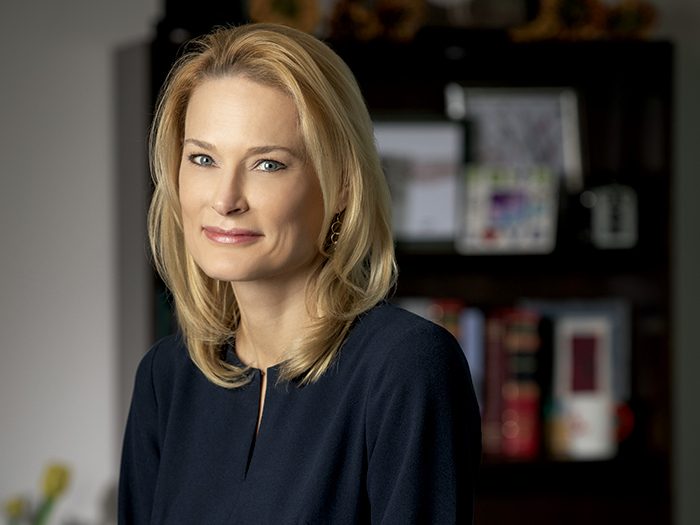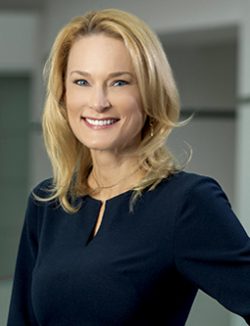How A Health Care Captive Director Drives Better Patient Outcomes

As the person charged with building the insurance captive infrastructure for Oklahoma’s sprawling academic health care system, Heather McClure’s experience and skill set was an ideal fit.
At a young age, McClure had a family member who was a high-IQ underachiever with undiagnosed learning disabilities — the kind of kid who children bullied on the playground and was misunderstood by teachers in the classroom.
Outrage on his behalf and a precocious talent for advocacy helped shape McClure. Those early lessons stuck with her.
“It was my responsibility to speak up,” McClure said. “I was the person who could translate.” As a girl in the Oklahoma of the 1970s and 1980s, she learned early to confront injustice without appearing confrontational. “I learned to be a speaker of truth to power, without aggression or hostility.”
Influenced by a friend’s parent, a legal aid attorney, McClure knew in high school that she would be an attorney, too. In college, she majored in journalism and political science, good prep for law school. A class on law in medicine refined her focus.
McClure spent the next decade as a litigator at a law firm, then directed litigation in-house for a large nonprofit health system in north Texas with a captive insurance structure.
Meanwhile, the market for professional liability insurance hardened across the country. Premiums for the University of Oklahoma (OU) academic medical practice spiked nearly 300 percent despite its good risk profile. To stabilize costs, OU created a captive, domiciled in Vermont.
In 2006, the CEO of the medical practice called McClure to run the Vermont-domiciled captive, build infrastructure within the parent organization in Oklahoma and manage its risks. She lived in Dallas and had kids in school there. She loved her job. She said no thanks.
He persisted.
“After three long calls,” she recalled, “he said the magic words: ‘You were born and raised in Oklahoma. You need to come home and help us.’ Something in me melted.”
She agreed to a hybrid telecommuting arrangement so she didn’t uproot her school-age children, hitting the road to Oklahoma at 5 a.m. two or three days per week. As it happened, OU was the perfect place to unleash the zeal for advocacy from her youth, giving a voice to the voiceless and vulnerable.
Captive as Advocate
OU Medicine is big. The academic medical practice includes two health sciences campuses, three partner hospitals, a cancer center, a breast health network and a rehab hospital.
McClure is chief risk officer for the system. She’s also an executive director of operations for OU’s academic medical practice, which covers 2,300 faculty physicians, resident physicians and medical students. That’s a lot of professional liability to manage and insure.

Heather McClure, chief risk officer, OU Medicine
McClure assumed management of OU’s captive when it was already eight months old, “but it’s her baby,” said Kyle Sweet, managing partner, Sweet Law PLC in Oklahoma City and a defense counsel panel member.
Her baby, he clarified, and that of an army of captive-model evangelists she flipped after a brief challenge by some who thought OU shouldn’t be in the self-insurance business.
McClure calls herself a “coach and teacher for the captive model,” which “allows an organization to put its money where its mouth is by controlling its own risks and betting on itself to do better than a for-profit insurance company.”
In the first years, McClure had to win over internal and external skeptics who saw captives only as a financing tool rather than a safety improvement tool.
She and her team set about building patient safety committees and a risk and claims management staff. She persuaded the board of directors to fund risk grants for safety initiatives. The risk profile improved, starting the positive trend that continues today.
McClure described the captive formula: Improved safety = fewer injuries = lower losses = more $ for operating budgets for a high-quality practice
For example, Sweet credits the captive with reducing informed consent-related claims by funding the purchase of technology that supplements the required informed consent process.
“Patients are properly informed and therefore safer, and physicians spend the same amount of time with patients,” Sweet said.
An additional benefit, McClure said, is that the modules answer more questions than patients could absorb in a single conversation with a provider.
The captive funds many more programs, such as online risk management education for physicians and other providers. It also funds a team of three board-certified physicians who spend 20 percent of their time helping clinical risk managers respond to real-time risk events, assessing trends and setting a vision for patient safety.
The commercial insurance model doesn’t preclude that kind of vigilance, but the captive model motivates hypervigilance, McClure said. “You pay closer attention when you have skin in the game.”
The captive has saved millions of dollars in premiums, she said, but perhaps its greatest value is elevating the importance of safety and risk to the highest levels of leadership.
For example, said Amy Middleman, M.D., a physician specializing in adolescent medicine, McClure joined her in defining best practices and policies regarding the confidentiality of adolescent patient records, which reduces the risk of tragic outcomes.
“Confidentiality is the major tenet of adolescent care,” Middleman said. Think: gender issues, pregnancy, depression, substance abuse, etc. — all the things that make adolescence a struggle. “If a teen feels uncomfortable talking to a parent, we want her to talk candidly to a provider for medical recommendations, not to friends and the internet.”
“Heather understands the issues and is willing to fight for the rights of vulnerable adolescents who otherwise don’t have a voice in a large system run by adults. She’s moving the care of adolescents forward in Oklahoma,” Middleman said.
Incident Reduction
Although McClure is employed by the provider organization, she emphatically sees no conflict of interest between patients’ well-being and her role in facilitating the captive model. “Our focus is not defending every claim to the max and taking it to trial,” she said.
When negative outcomes occur, McClure’s childhood role of translator and advocate kicks in. She explains what happened to patients and families.
“I can translate when patients and providers don’t speak the same language. There is never a conflict with finding out what happened and telling patients the truth.”
When there may be culpability, “we want to make patients whole. We can act swiftly and creatively because we have no need to wait for a separate insurance company to fund compensation for families and patients.”
“She wants to change the world. She truly cares.” — Andrea Jones, president, Healthcare Insurance Professionals
That makes a huge difference to families, McClure said, and it’s often a pleasant surprise.
In the absence of negligence, she said, “we try to explain the bad outcome. The attempt at communication goes a long way to heal resentment.”
Incident prevention extends to the education of future physicians. “We’re meeting a lot of educational goals with captive funds,” Sweet said. OU surgical residents’ training includes mock cross-examinations and depositions based on actual cases. That training, according to surveys of residents, doesn’t necessarily alleviate anxiety around litigation, but it eases anxiety around obtaining and managing professional liability insurance.
“That’s revolutionary,” Sweet said. “Heather’s using the captive not only to improve the quality of service and medical outcomes. She’s also improving physicians’ quality of life.”
She Just Cares
After speaking with a handful of McClure’s friends and associates, the descriptive words start to repeat. Advocate, of course. Tactful. Politically adept. Dog with bone. Passionate but cool-headed. Multitasker.
Andrea Jones, president, Healthcare Insurance Professionals, traveled with McClure to a meeting of the Vermont Captive Insurance Association (VCIA), on whose board McClure is finishing two three-year terms. A work crisis arose.
“Heather was out of town, texting and multitasking,” said Jones, a friend and colleague. “Most people would say, ‘that can wait a day,’ but she left the room to deal with the drama. She returned after a while, back on her game as if nothing had happened.”
Todd Hagemeier, managing director, Alliant Insurance Services, saw that nimbleness in action last year when the captive brought the professional and general liability risks of the teaching hospitals under its cover. The two policyholders have crossover leadership but retain separate structures.
Jointly funding and managing their risks meant a delicate merger of the aligned interests of the hospital system, the medical practice and the captive insurance company (where she is chief legal officer). “Heather gave herself a crash course in all of the complex legal and regulatory work necessary to accomplish the organization’s complex goals,” he said.
“She maintained the trust of all these people with big personalities,” Hagemeier said. Apart from the mechanics of risk financing, the networking and problem solving, “managing multiple bosses is a rare skill. She’s like a sponge to benefit her organization.”
At the same time, he said, she engaged in frequent speaking engagements to educate others about the benefits of the captive model, including meetings of captive and risk management associations whose members are leaders in their fields: telecom, agriculture and health care.
McClure is licensed to practice law in Texas, where she lives; Oklahoma, where she works; and Vermont, the largest domicile in the United States to captives. It boasts 48 of the Fortune 100 companies and over another thousand with risk across the country.
Vermont’s financial regulation statistics are impressive, she said, but the real key to her loyalty is that “every time I call the Vermont insurance regulators to ask a question or brainstorm a solution, they pick up the phone and talk.”
Educating professionals about the captive model has been an important part of her role as a board member.
“I keep going back to ‘passion,’ ” said Jones. “She wants to change the world. She truly cares.”
That passion extends to her job — to her commitment to captives, to her family, to advocacy for the voiceless and vulnerable, and to her commitment to geriatric rescue dogs nobody else would take on.
McClure interrupted one phone interview for this profile to attend to a veterinary emergency for her 17-year-old miniature dachshund, Tootsie. Tootsie is back at home and doing well. &










